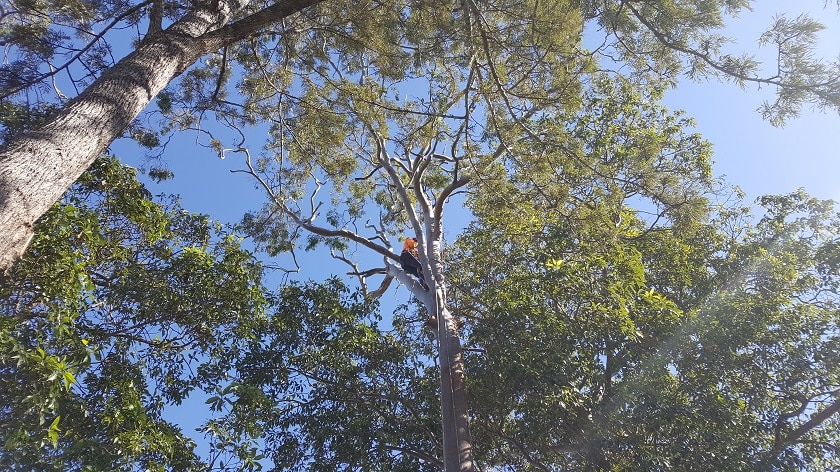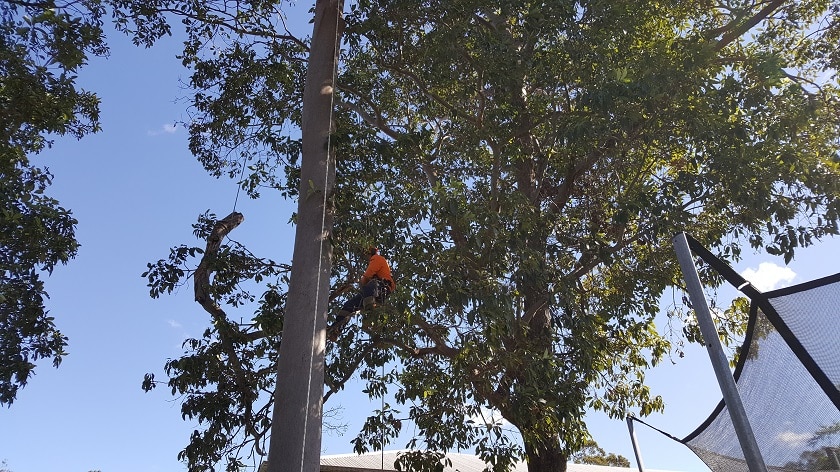We are often asked to trim trees in Brisbane with the goal of improving their health. Pruning for pruning’s sake does not help a tree, so at those times we are more likely to recommend soil amendments unless in our assessment the tree actually needs pruning.
The most common reasons for pruning trees are:
- Removing dangerous branches that have regrown from storm damage or tree lopping,
- Remediating codominant branches,
- Removing dead wood,
- Training a tree to grow away from a house or boundary,
- Regenerative pruning, and
- Formative pruning.
Pruning dangerous regrowth
If a tree has been damaged by a storm and a branch has failed away from branch unions or unqualified tree loppers have pruned a tree then a bunch of long, spindly, branches are likely to grow from the wound. They are sometimes called, ‘watersprouts’, while we call them and epicormic complex. The term comes from the origin of the buds just under the bark. Because of this location they have a weak join to the previous branch and can fail quite easily. Also, because they are clumped together around the wound, they push each other off their joins as they grow.
Because of the proliferation of tree loppers in Australia, this epicormic branching is a real issue in arboriculture. The guidance in our standard, AS4373-2007 Pruning of Amenity Trees, on how to deal with epicormic complexes is to remove all epicormic branches. Of course the result of doing so is that either the branch dies as there is no production of photosynthates, or another epicormic complex forms.
It might seem that if a tree lopper has pruned your tree there is no hope for it, but fairly recently a school of arborists who call themselves arborculturalists have proposed remediation of lopped limbs by removing most of the regrowth but permitting perhaps two of the sprouts to remain. The theory is they will have more resources and more room to grow than if the branch hadn’t been remediated so they will be able to grow strong and form an ‘endocormic’ (from within) union.
While we usually stick to the Australian Standard, in this case we do look for opportunities where we can remediate lopped branches due to the benefit to the tree. The take-away from all this should be to only have qualified arborists prune your trees in the first place.
Remediating codominant branches
Studies have proven branches with a narrow angle at the branch union are more likely to fail (Smiley, 2007). There are further ways we assess codominant branches to judge their likelihood of failure. Perhaps the most important isn’t the branch itself, but what it will damage if it does fail.
We don’t always remove codominant branches. Besides the angle of the branch union, some other codominant branch factors we assess are cracks, cankers, leanness of the branches, and the weight of the foliage.
Removing dead wood
Borers are a problem in gum trees, paperbarks, poincianas, mangos, and pine trees, among others. The borers usually attack stressed trees, especially dead branches. It’s a good reason to prune dead branches.
So is the danger of dead branches falling on someone or damaging property. Once a branch isn’t sustainable, the tree starts a process of shedding it. An abscission zone is formed near the branch or leader to which it is attached that is corky and full of microbial substances. At that point the tree can drop the branch, so it is quite dangerous. In a residential or commercial property we would normally recommend the branch be pruned when we can assess the branch as marked for abscission by the tree.
Training a tree
A core skill of a climbing arborist is to be able to remove a branch in such a way that it doesn’t lead to regrowth. We do this by pruning at the right angle just outside the branch collar. There’s a plant hormone located near branch unions that helps a tree to seal over. A tree that seals a wound is much more likely to not sprout branches in the same place.
In that way, we can train a tree as we prune it so it will not continue to grow over a building or fenceline. It’s more economical contracting an arborist rather than a tree lopper as you are less likely to need the tree pruned again in the future.
Regenerative Pruning
Regenerative pruning is a technique carried out to restore the vitality and extend the life of aged trees. It’s a specialised skill that was developed in Europe for heritage trees. We are pleased to be among the few Australian arborists who practice regenerative pruning as we believe retaining old trees is important for the environment, our heritage, and our fauna.
Regenerative pruning is recognised in many countries’ pruning standards but isn’t yet included in AS4373:2007 Australian Standard for Pruning of Amenity Trees to which we otherwise adhere. Hopefully more Australian arborists will catch up with arborists in other countries in their care for their important tree specimens.
Formative Pruning
Formative pruning is the pruning of juvenile trees in such a way they are likely to be safe and healthy trees when they are mature. We prune to reduce faults such as codominant leaders and to improve strength by encouraging growth in lean branches. It makes sense because of the low cost of pruning a small tree compared to a mature one.
We can also easily train a tree to grow in the desired shape and in a way that avoids structures and neighbouring properties. Some nurseries conduct formative pruning before tree stock leaves the nursery. Others leave it up to the purchaser.


